By William Pearce
In March 1980, the Soviet government envisioned a fast-attack force utilizing missile-carrying ekranoplans. An ekranoplan (meaning “screen plane”), also known as wing-in-ground effect (WIG) or ground-effect-vehicle (GEV), is a form of aircraft that operates in ground effect for added lift. The machines typically operate over water because of their need for large flat surfaces.
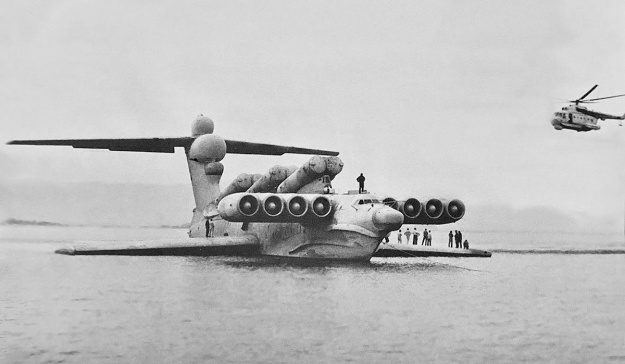
The missile-carrying Lun ekranoplan at rest on the Caspian Sea. The craft exhibits worn paint in the undated photo. Note the gunner’s station just below the first missile launcher. A Mil Mi-14 helicopter is in the background.
When the missile-carrying ekranoplan was being considered, the huge KM (Korabl Maket) ekranoplan was being tested, and testing was just starting on the three production A-90 Orlyonok transport ekranoplans. Known as Project 903, the missile-carrying Lun-class ekranoplans would be built upon the lessons learned from the earlier machines. The word “lun” (лунь) is Russian for “harrier.” An order for four examples was initially considered, with the number soon jumping to 10 Lun-class machines.
The first Lun-class ekranoplan was designated S-31, with some sources stating the designation MD-160 was also applied. Most sources referred the craft simply as “Lun.” The Lun was designed by Vladimir Kirillovykh at the Alekseyev Central Hydrofoil Design Bureau in Gorky (now Nizhny Novgorod), Russia. The new craft differed from previous ekranoplans by not having dedicated cruise engines.

The Lun at speed traveling over the water’s surface. Note the contoured, heat-resistant surface behind each missile tube to deflect the exhaust of the launching missile. The large domes on the tail are evident in this image.
The Lun’s all-metal fuselage closely resembled that of a flying boat with a stepped hull. Mounted just behind the cockpit were eight Kuznetsov NK-87 turbojets, each capable of 28,660 lbf (127.5 kN) of thrust. The engines were mounted in sets of four on each side of the Lun. The nozzle of each jet engine rotated down during takeoff to increase the air pressure under the Lun’s wings (power augmented ram thrust). This helped the craft rise from the water’s surface and into ground effect. The nozzles were positioned straight back for cruise flight.
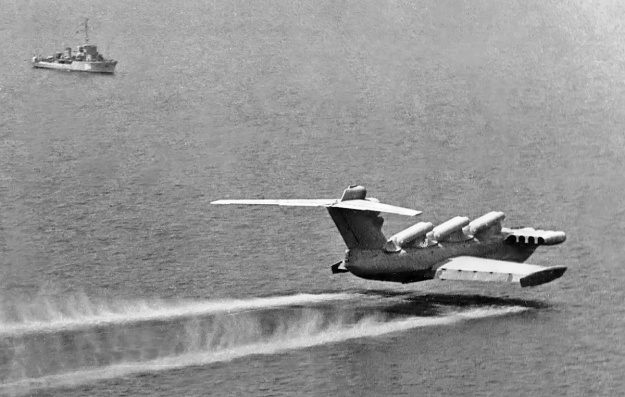
With flaps down, the Lun passes by a Soviet Navy ship. The rear gunner’s position is just visible at the rear of the craft.
The mid-mounted, short span wings had a wide cord and an aspect ratio of 3.0. Six large flaps made up the trailing edge of each wing, with the outer flaps most likely operating as flaperons (a combination flap and aileron). The tip of each wing was capped by a flat plate that extended down to form a float. A single hydro-ski was positioned under the fuselage, where the wings joined. The hydraulically-actuated ski helped lift the craft out of the water as it picked up speed. A swept T-tail with a split rudder at its trailing edge rose from the rear of the fuselage. Radomes in the tail’s leading edge housed equipment for navigational and combat electronics. The large, swept horizontal stabilizer had large elevators mounted to its trailing edges.
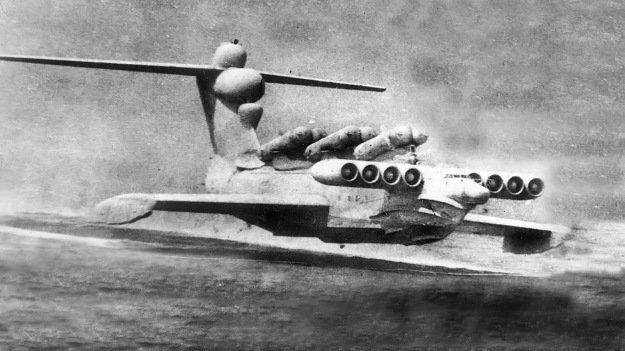
Looking more like an alien ship out of a science fiction movie than a cold-war experiment, the Lun was an impressive sight. Note the chines on the bow to help deflect water from the engines.
Mounted atop the Lun were three pairs of angled missile launchers. No cruise engines were mounted to the Lun’s tail over concerns that the engines would cut out when they ingested the exhaust plume from a missile launch. The launchers carried the P-270 (3M80) Moskit—a supersonic, ramjet-powered, anti-ship cruise missile. The P-270 traveled at 1,200 mph (1,930 km/h) and had a range of up to 75 miles (120 km). The belief was that the Lun-class ekranoplans would be able to close in on an enemy ship undetected and launch the P-270 missile, which would be nearly unstoppable to the enemy ships. The Lun also had two turrets, each with two 23 mm cannons. One turret was forward-facing and positioned below the first pair of missile launchers. The second turret was rear-facing and positioned behind the Lun’s tail.
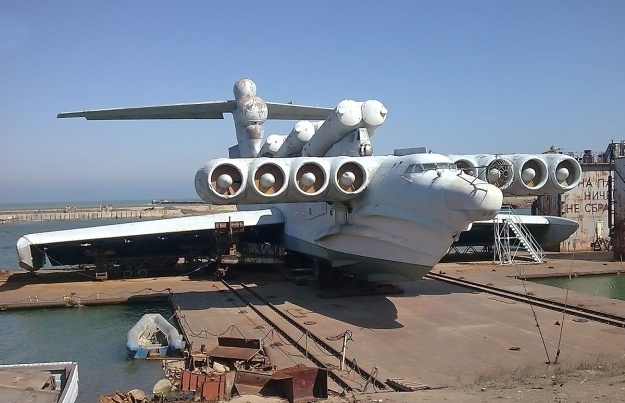
View of the Lun in March 2009 as it sits slowly deteriorating at the Kaspiysk base on the Caspian Sea. The special dock was made for the Lun. The dock was towed out to sea and submerged to allow the Lun to either float free for launch or be recovered.
The Lun had a wingspan of 144 ft 4 in (44.0 m), a length of 242 ft 2 in (73.8 m), and a height of 62 ft 11 in (19.2 m). The craft had a cruise speed of 280 mph (450 km/h) and a maximum speed of 342 mph (550 km/h). Operating height was from 3 to 16 ft (1 to 5 m), and the Lun had an empty weight of 535,723 lb (243,000 kg) and a maximum weight of 837,756 lb (380,000 kg). The craft had a range of 1,243 miles (2,000 km) and could operate in seas with 9.8 ft (3 m) waves. The Lun had a crew of 15 and could stay at sea for up to five days.
The Lun was launched on the Volga River on 16 July 1986. Operating from the base at Kaspiysk, Russia, testing occurred on the Caspian Sea from 30 October 1989 to 26 December. By that time, plans for the Lun-class of missile-carrying ekranoplans had faded, and the decision was made that only one of the type would be built. The Lun was withdrawn from service sometime in the 1990s and stored at Kaspiysk, where it remains today. In 2002, there was talk of reviving the missile-carrying ekranoplan, but no action was taken.

An interesting view of the Lun sitting at Kaspiysk in late-2009. Note the downward angle of the jet nozzles, and the flaps appear to be disconnected. The elements have taken a toll on the ekranoplan. (igor113 image)
The second machine (S-33), which was about 75-percent complete, was converted to serve as a Search and Rescue (SAR) craft. This decision was in part due to the loss of the K-278 Komsomolets submarine on 7 April 1989. A fire caused the loss of the submarine, and 42 of the 69-man crew died, many from hypothermia as they awaited rescue. This accident illustrated the need for a fast-response SAR craft.

The Spasatel in mid-2014 at the Volga Shipyard with a protective wrap to help preserve the craft. The wings and horizontal stabilizers are resting on the ekranoplan’s back. Note the machine’s reinforced spine. (rapidfixer image)
For its new purpose, S-33 was named Spasatel for “Rescuer.” Conversion work was started around 1992. The Spasatel had the same basic configuration as the Lun but had a reinforced spine and an observation deck placed atop its tail. The Spasatel possessed the same dimensions and performance as the Lun. However, sources state that the Spasatel would fly out of ground effect. For sea search missions, the craft would fly at an altitude of 1,640 ft (500 m), and it had a ceiling of 24,606 ft (7,500 m). The Spasatel had a range of 1,864 miles (3,000 km).

The Spasatel seen in late 2018 at the Volga / Krasnoye Sormovo Shipyard in Nizhny Novgorod. The craft has been outside and exposed to the elements since 2016. Note the observation deck incorporated into the tail. (Андрей Орехов / Andrey Orekhov image)
The SAR ekranoplan would be quickly altered based on its mission. The Spasatel could carry up to 500 passengers, or temporarily hold 800 people for up to five days waiting for rescue. As a hospital ship, 80 patients could be treated on the Spasatel. A tank with 44,092 lb (20,000 kg) of fire retardant could be mounted atop the Spasatel for fighting fires on ships or oil platforms. Or, a submersible with space for 24 people could be mounted on the Spasatel for responding to submarine accidents. The Spasatel could even respond to oil spills and lay out 9,843 ft (3,000 m) of barriers. Even more ambitious was the noble plan to have several Spasatel ekranoplans in-service around the world ready to respond to any call of marine distress at a moment’s notice.
The Spasatel was about 80-percent complete when work was halted in the mid-1990s due to a lack of funds. In 2001, there was renewed hope that the Spasatel would be completed, but again, no money was forthcoming. The Spasatel was housed in the construction building at the Volga Shipyard until 2016, when it was moved outside. In 2017, there was again some hope that the Spasatel would be completed, now for SAR missions in the Arctic. Under this plan, work on the Spasatel would continue from 2018 until its completion around 2025. However, it does not appear that any work has been done, and the Spasatel continues to deteriorated as it sits exposed to the elements.
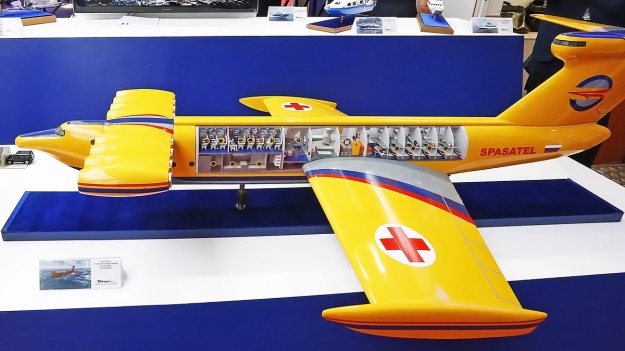
Spasatel model from 2017 depicting its new purpose as an artic rescue craft. It does not appear that any work has been performed on the actual machine, but who knows what the future may hold. (Valery Matytsin/TASS image via The Drive)
Sources:
– Soviet and Russian Ekranoplans by Sergy Komissarov and Yefim Gordon (2010)
– WIG Craft and Ekranoplan by Liang Lu, Alan Bliault, and Johnny Doo (2010)
– https://s1rus.livejournal.com/154716.html
– https://www.thedrive.com/the-war-zone/15542/russia-supposedly-bringing-back-giant-ekranoplans-for-arctic-missions
– http://iiaat.guap.ru/?n=main&p=pres_spasatel
– https://en.wikipedia.org/wiki/Spasatel
– https://igor113.livejournal.com/51213.html
– https://igor113.livejournal.com/52174.html
– https://igor113.livejournal.com/52878.html


Wow, a boat hull of an aircraft! I had never seen or heard of it. Nice!
wonderful research. Thank you for this!
One more link with tech data & scheme (in Russian)
http://www.airwar.ru/enc/sea/lun.html